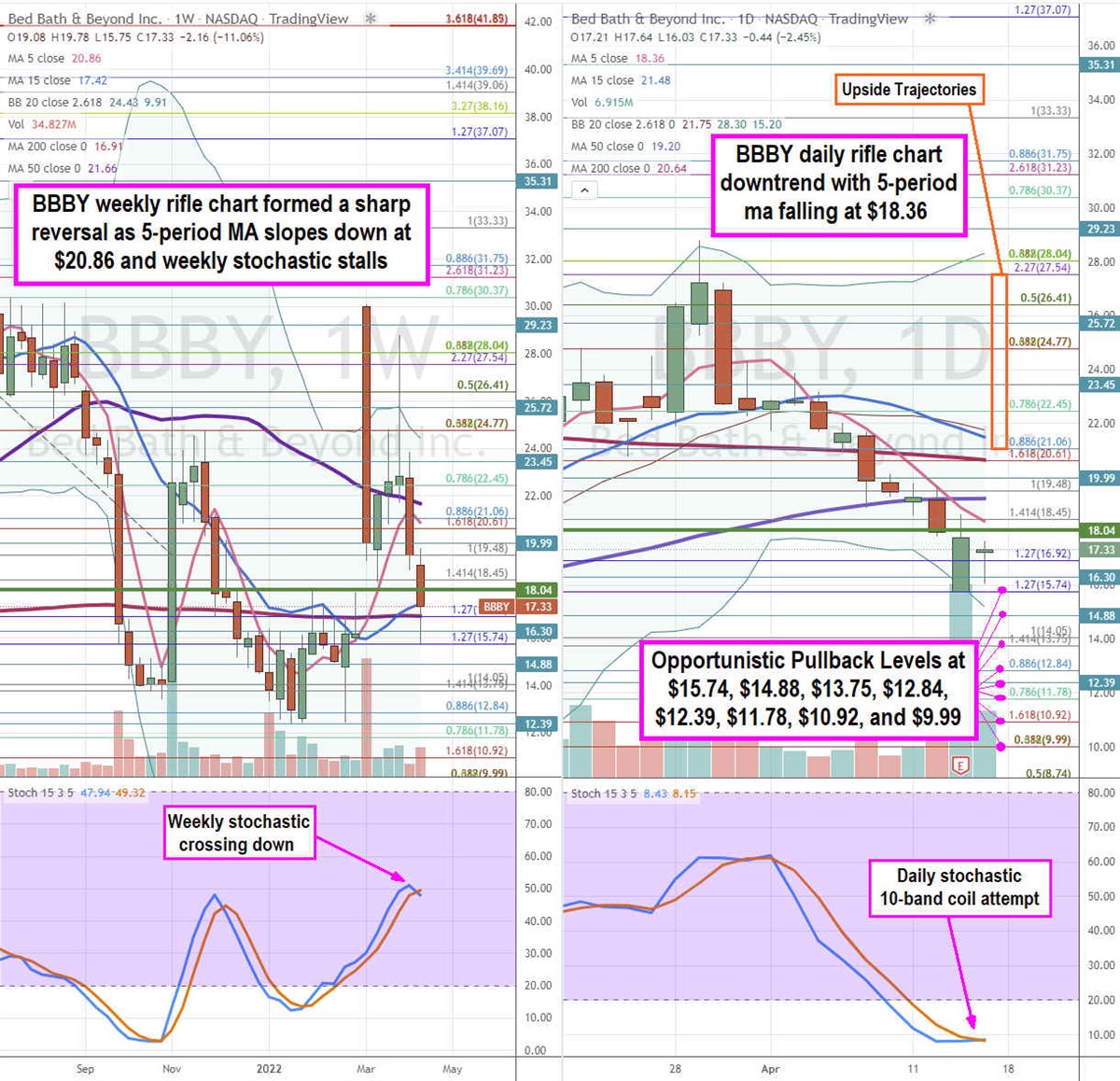Home goods retailer
Bed Bath Beyond NASDAQ: BBBY stock has collapsed on its fiscal Q4 2021 earnings massive shortfall. The former high-flying
meme stock blamed the
lack of inventory and rising supply chain costs as the key headwinds that spoiled the party. Freight and shipping costs
inflation also hit margins by 170 bps. Its buybuy Baby subsidiary did manage to deliver on its $1.4 billion 2021 sales goal. Management presented a gloomy picture of devastating macroeconomic
headwinds ranging from the ravaged global
supply chain, ongoing effects from the Omicron variant,
skyrocketing inflation, rising interest rates,
geopolitical strife and uncertainty having an impact on consumer confidence and hurting sales. Shares received a momentary glimmer of hope when they spiked up to a high of $28.78 on news of activist investor and 9.8% beneficial owner Ryan Cohen’s RC Ventures entering into a cooperation agreement to gain three board seats and joining a Strategy Committee to explore strategic alternatives to unlock value. However, that pop was short-lived as shares collapsed to $15.74 on its fiscal Q4 2021 earnings release. The new Board of Directors will temporarily expand to 14 members following its Annual Meeting. Prudent investors seeking to gain exposure ahead of a
rebound can watch for opportunistic pullbacks in shares of Bed Bath & Beyond.
Q4 FY Fiscal 2021 Earnings Release
On April 13, 2022, Bed Bath & Beyond released its fourth-quarter fiscal 2021 results for the quarter ending February 2022. The Company reported an earnings-per-share (EPS) loss of (-$0.92) excluding non-recurring items versus consensus analyst estimates for a loss of (-$0.03), a (-$0.95) miss. The Company blamed shortfalls on supply chain challenges. Revenues fell (-21.7%) year-over-year (YoY) to $2.05 billion, missing consensus analyst estimates for $2.08 billion. Bed Bath & Beyond CEO Mark Tritton commented, “We are disappointed that our sales and gross margin performance does not reflect our team's hard work and execution against both strategic and transformation efforts in 2021. Macroeconomic factors, such as the disruption of the global supply chain, the Omicron variant, as well as the geopolitical turbulence weighing on consumer confidence, have uncovered more vulnerabilities than we could have foreseen at this stage of our transformation, as we completely rebuild the foundation of our business. The lack of available inventory to sell proved to be a continuing impediment to sales through the remainder of the fourth quarter and into the early part of fiscal 2022. Specifically, despite our overall inventory levels, product in transit, not available for sale or held at port remained abnormally high, particularly in key items. We estimate an impact of approximately $175 million to our fourth-quarter sales, or a high-single digit deficit, as a result of a lack of in-stock availability in our Bed Bath banner."
CEO Commentary
Bed Bath & Beyond CEO Mark Britton set the tone with the disappointing performance placing blame mostly on rising supply chain costs leading to a shortage of inventory. Their not-available-to-sell inventory remained around 30% across key categories despite the Company’s initial projections to return to normal in Q4. Major items that were promoted in advertisements become out-of-stock quickly. He painted a gloomy narrative of extraordinary macroeconomic conditions including the derailing of the global supply chain, continued effects from COVID, inflation, rising interest rates and geopolitical tensions impacting consumer behavior. Rising supply chain costs led to Q4 2021 comparable sales of (-12%) and adjusted gross margins of 28.8%. February 2022 industry trends continued to worsen due to macro market volatility. Escalating freight and shipping costs cut into margins, which would have been 32.4%. The Company initiated remodeling 131 stores and completed 80 stores while closing down over 200 underperforming stores. Key focus areas for the year will be inventory, pricing, and traffic. The Company also plans to launch a new loyalty program this year.

BBBY Opportunistic Pullback Price Levels
Using the rifle charts on the weekly and daily time frames provides a precision view of the landscape for BBBY stock. The weekly rifle chart bottomed out on earnings at the $15.74 Fibonacci (fib) level. The weekly rifle chart uptrend stalled as shares dropped sharply on the earnings. The weekly 50-period moving average (MA) resistance sits at $21.66. The weekly 5-period MA is sloping down at $20.86 as 15-period MA flattens at $17.42. The weekly 200-period MA sits at $16.91. The weekly stochastic peaked and is crossing back down at the 50-band. The weekly market structure low (MSL) buy triggers on a breakout above $18.04. The daily rifle chart has a downtrend with a falling 5-period MA at $18.36 and 50-period MA at $19.20. The daily 200-period MA resistance is at $20.64 and 15-period MA is falling at $21.48. The daily lower Bollinger Bands (BBs) sit at $15.20. The daily stochastic is smothered under the 10-band as it attempts to cross back up. Prudent investors can watch for opportunistic pullback levels at the $15.74 fib, $$14.88, $13.75 fib, $12.84 fib, $12.39, $11.78 fib, $10.92 fib, and the $9.99 fib level. Upside trajectories range from the $21.06 fib level to the $27.54 fib level.
Before you consider Bed Bath & Beyond, you'll want to hear this.
MarketBeat keeps track of Wall Street's top-rated and best performing research analysts and the stocks they recommend to their clients on a daily basis. MarketBeat has identified the five stocks that top analysts are quietly whispering to their clients to buy now before the broader market catches on... and Bed Bath & Beyond wasn't on the list.
While Bed Bath & Beyond currently has a Hold rating among analysts, top-rated analysts believe these five stocks are better buys.
View The Five Stocks Here
Looking to profit from the electric vehicle mega-trend? Enter your email address and we'll send you our list of which EV stocks show the most long-term potential.
Get This Free Report
Like this article? Share it with a colleague.
Link copied to clipboard.